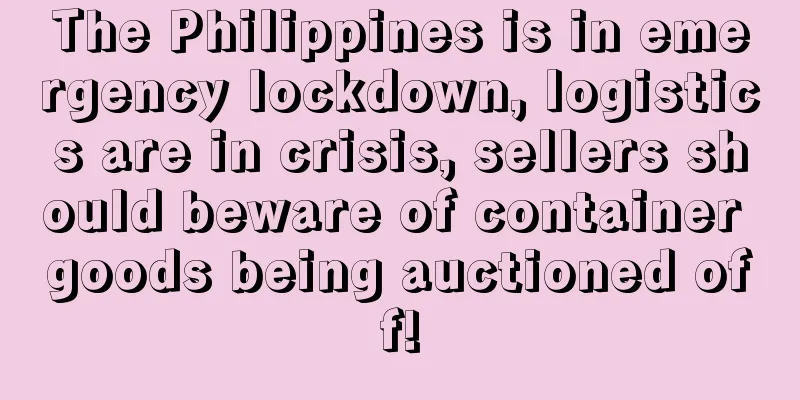The Philippines is in emergency lockdown, logistics are in crisis, sellers should beware of container goods being auctioned off!

|
Philippines imposes one-month entry ban According to foreign media reports, the Philippine government announced on the evening of the 16th that in order to curb the rebound of the epidemic, the Philippines will temporarily ban foreign citizens and some overseas Filipinos from entering the country. The entry ban took effect on March 20 and ended on April 19, lasting one month . In addition, the Civil Aviation Authority of the Philippines also announced on the 16th that the number of passengers entering the Manila International Airport will be limited to less than 1,500 per day starting from the 18th for a period of one month. Manila, the capital of the Philippines, as a hard-hit area by the epidemic, has implemented measures such as partial lockdown in areas with high infection rates. For example, the age limit for going out in the anti-epidemic curfew order will be expanded, and people under the age of 18 will not be allowed to go out for the time being. Philippine Airlines Inc. said in a Facebook post that it may cancel some international flights. Recently, the epidemic in the Philippines has shown a rapid rebound trend. As of Tuesday this week, the Philippines had 4,437 new confirmed cases of COVID-19 , the highest number of new cases in a single day since mid-August last year. The cumulative number of confirmed cases has exceeded 631,000. It is also the second country with the most confirmed cases in Southeast Asia, second only to Indonesia. Newly confirmed cases, entry bans, and flight cancellations, these words remind people of the previous nationwide lockdown in Malaysia. Sellers beware of customs auction of stranded containers The above situation also conveys some information to sellers who have cross-border business dealings in the Philippines. On the one hand, during the implementation of the lockdown, physical store business will inevitably be affected, while online shopping may surge. Filipinos may buy a large amount of supplies online, which may be another opportunity for sellers who are stockpiling goods . On the other hand, entry bans and flight cancellations also mean that logistics may be delayed on a large scale. During the one-month blockade, sellers may face the situation of having orders but no goods, and last-end delivery is also a headache. Previously, severe congestion at Singapore and Chittagong ports, Malaysia’s lockdown, and the Myanmar crisis that caused shipping companies to suspend bookings had made Southeast Asian logistics look terrible. Containers are floating on the sea and cannot land. Due to the chain reaction of port congestion and supply chain damage, the sea transportation channel has been severely damaged. At the end of January, due to severe port congestion and mountains of containers, the Philippine Customs publicly auctioned nearly 2,000 stranded containers at different ports across the country , including goods such as televisions, tiles, plywood, etc. If port congestion worsens during this lockdown and a large number of containers are stranded again, perhaps the Philippine Customs will repeat its previous operations ... logistics Cross-border e-commerce market Southeast Asia |
<<: Germany's third wave of epidemic hits, beauty product sales fall 16%
Recommend
What is Yicang ERP & Yicang ERP Review
Yicang ERP is a simple and efficient cross-border...
What is Neutrogena? Neutrogena Review, Features
Neutrogena is a dermatologist-recommended skincar...
AWS outage reappears, Amazon sellers are blocked from creating shipments
Yesterday , more than 20 Amazon sellers posted on...
Grocery e-commerce is growing rapidly, Tyson Foods optimizes the online shopping experience
In today's rapidly evolving e-commerce world ...
Walmart Brazil sells stake, further exiting Brazilian grocery market
According to foreign media reports , Walmart Braz...
What is MensUnderwearStore? MensUnderwearStore Review, Features
<span data-docs-delta="[[20,{"gallery"...
The "Black Myth: Wukong" co-branded controller was first launched on AliExpress and sold out in 10 seconds!
The "Black Myth: Wukong" co-branded con...
Newegg is holding a 21st anniversary promotion
On January 12 , North American technology electro...
A BUG was found in the e-commerce platform plug-in! Can shoppers change the price by themselves?
WooCommerce is a popular e-commerce platform with...
Korean media: AliExpress grows rapidly, driving South Korea's cross-border e-commerce transaction volume to a record high
According to Korean media reports, China's cr...
What is YDH International Logistics (YDH)? YDH International Logistics (YDH) Review, Features
Yida International Logistics (Shanghai Yida Intern...
What is FragranceX? FragranceX Review, Features
Founded in 2001, FragranceX is the world's lar...
Acquisition terminated! The sale of the remaining equity of Shenzhen Damai failed, and the store data was further disclosed
Not long ago, the news that Shenzhen's popula...
After failing to open a store, the seller complained about Amazon and was laughed at by others...
Recently, the editor discovered on Amazon's o...
Awesome! Another big seller launched
Cross-border markets are constantly changing, but...









